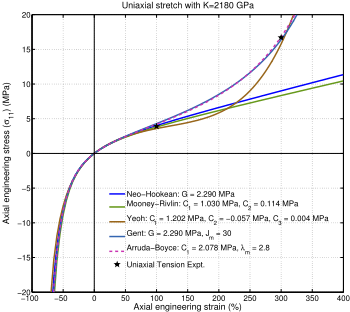Arruda–Boyce model
| Continuum mechanics | ||||
|---|---|---|---|---|
|
Laws
|
||||
In continuum mechanics, an Arruda–Boyce model[1] is a hyperelastic constitutive model used to describe the mechanical behavior of rubber and other polymeric substances. This model is based on the statistical mechanics of a material with a cubic representative volume element containing eight chains along the diagonal directions. The material is assumed to be incompressible.
The strain energy density function for the incompressible Arruda–Boyce model is given by[2]
where is the number of chain segments, is the Boltzmann constant, is the temperature in kelvins, is the number of chains in the network of a cross-linked polymer,
where is the first invariant of the left Cauchy–Green deformation tensor, and is the inverse Langevin function which can approximated by
For small deformations the Arruda–Boyce model reduces to the Gaussian network based neo-Hookean solid model. It can be shown[3] that the Gent model is a simple and accurate approximation of the Arruda–Boyce model.
Alternative expressions for the Arruda–Boyce model
An alternative form of the Arruda–Boyce model, using the first five terms of the inverse Langevin function, is[4]
where is a material constant. The quantity can also be interpreted as a measure of the limiting network stretch.
If is the stretch at which the polymer chain network becomes locked, we can express the Arruda–Boyce strain energy density as
We may alternatively express the Arruda–Boyce model in the form
where and
If the rubber is compressible, a dependence on can be introduced into the strain energy density; being the deformation gradient. Several possibilities exist, among which the Kaliske–Rothert[5] extension has been found to be reasonably accurate. With that extension, the Arruda-Boyce strain energy density function can be expressed as
where is a material constant and . For consistency with linear elasticity, we must have where is the bulk modulus.
Consistency condition
For the incompressible Arruda–Boyce model to be consistent with linear elasticity, with as the shear modulus of the material, the following condition has to be satisfied:
From the Arruda–Boyce strain energy density function, we have,
Therefore, at ,
Substituting in the values of leads to the consistency condition
Stress-deformation relations
The Cauchy stress for the incompressible Arruda–Boyce model is given by
Uniaxial extension

For uniaxial extension in the -direction, the principal stretches are . From incompressibility . Hence . Therefore,
The left Cauchy–Green deformation tensor can then be expressed as
If the directions of the principal stretches are oriented with the coordinate basis vectors, we have
If , we have
Therefore,
The engineering strain is . The engineering stress is
Equibiaxial extension
For equibiaxial extension in the and directions, the principal stretches are . From incompressibility . Hence . Therefore,
The left Cauchy–Green deformation tensor can then be expressed as
If the directions of the principal stretches are oriented with the coordinate basis vectors, we have
The engineering strain is . The engineering stress is
Planar extension
Planar extension tests are carried out on thin specimens which are constrained from deforming in one direction. For planar extension in the directions with the direction constrained, the principal stretches are . From incompressibility . Hence . Therefore,
The left Cauchy–Green deformation tensor can then be expressed as
If the directions of the principal stretches are oriented with the coordinate basis vectors, we have
The engineering strain is . The engineering stress is
Simple shear
The deformation gradient for a simple shear deformation has the form[6]
where are reference orthonormal basis vectors in the plane of deformation and the shear deformation is given by
In matrix form, the deformation gradient and the left Cauchy–Green deformation tensor may then be expressed as
Therefore,
and the Cauchy stress is given by
Statistical mechanics of polymer deformation
The Arruda–Boyce model is based on the statistical mechanics of polymer chains. In this approach, each macromolecule is described as a chain of segments, each of length . If we assume that the initial configuration of a chain can be described by a random walk, then the initial chain length is
If we assume that one end of the chain is at the origin, then the probability that a block of size around the origin will contain the other end of the chain, , assuming a Gaussian probability density function, is
The configurational entropy of a single chain from Boltzmann statistical mechanics is
where is a constant. The total entropy in a network of chains is therefore
where an affine deformation has been assumed. Therefore the strain energy of the deformed network is
where is the temperature.
Notes and references
- ↑ Arruda, E. M. and Boyce, M. C., 1993, A three-dimensional model for the large stretch behavior of rubber elastic materials,, J. Mech. Phys. Solids, 41(2), pp. 389–412.
- ↑ Bergstrom, J. S. and Boyce, M. C., 2001, Deformation of Elastomeric Networks: Relation between Molecular Level Deformation and Classical Statistical Mechanics Models of Rubber Elasticity, Macromolecules, 34 (3), pp 614–626, doi:10.1021/ma0007942.
- ↑ Horgan, C. O. and Saccomandi, G., 2002, A molecular-statistical basis for the Gent constitutive model of rubber elasticity, Journal of Elasticity, 68(1), pp. 167–176.
- ↑ Hiermaier, S. J., 2008, Structures under Crash and Impact, Springer.
- ↑ Kaliske, M. and Rothert, H., 1997, On the finite element implementation of rubber-like materials at finite strains, Engineering Computations, 14(2), pp. 216–232.
- ↑ Ogden, R. W., 1984, Non-linear elastic deformations, Dover.
See also
- Hyperelastic material
- Rubber elasticity
- Finite strain theory
- Continuum mechanics
- Strain energy density function
- Neo-Hookean solid
- Mooney–Rivlin solid
- Yeoh (hyperelastic model)
- Gent (hyperelastic model)